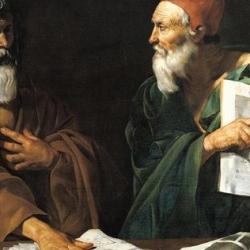Descartes’s early critics had many qualms about his new philosophy, but for theological critics the central question was how to square his views with the dogma of transubstantiation. Descartes claimed to be a faithful Roman Catholic, but philosophically he was opposed to the hylomorphic theory of matter on which traditional accounts of transubstantiation depended. Descartes had a variety of responses to attacks on his (mainly from Jesuits, who used attacks on Descartes to attack the Jansenists of Port Royal, wrongly thought to be thoroughgoing Cartesians). He sometimes retreated into mystery: If even Trent says that the miracle is beyond words, then Descartes surely cannot solve the mystery. At times, he or his followers distinguished between the dogma and the philosophical scaffolding that upheld it, the faith and the speculative explanations for the faith; at times, this parry verged toward a theory of double truth, which was probably as troublesome to his critics as his views.
In a 2001 article, Julian Bourg argues that Descartes developed his theory of “modes,” a central plank of his philosophical system, in the context of responding to questions about his views on transubstantiation. This flexible, ambiguous concept enabled Descartes to “to skirt between an orthodoxy that represented the past and an originality, not without dangers in his time, that seem to gesture toward our day. Foregrounded with regard to transubstantiation, ‘mode’ came to play an integral role in his mature metaphysics.”
“Mode” was a medieval term that meant “a way, manner, bound, limit, or method.” With the scholastics of the late thirteenth and fourteenth centuries, it was employed in a metaphysical sense to refer to “a manner or state of being of a thing: a thing considered as possessing certain attributes that do not belong to its essence, and may be changed without destroying its identity.” According to Suarez, “modes ‘modify a pre-existing entity’ to the degree that they ‘ultimately determine the state and manner of existing’ of that entity.”
Descartes used modes “to cover up the gaps in his dualistic theory of mind and matter.” According to his basic theory, the “distinction between res cogitans and res extensa supposed that each genre of substance existed univocally: all matter was extended except for thinking substance. For something to be, it had to fall within one of these categories; there were no exceptions or ambiguities.” But Descartes was a theist who believed that God created and sustained all things; that created what Bourg calls a degree of “equivocacy” in his understanding of mind and matter. Besides, Descartes recognized that, though there were only two classes of things and that each had a fundamental attribute (thinking for mind, extension for matter), in reality both had all sorts of different features: “there were . . . many . . . features of matter (number, color, density, size, etc.) and many other states of mind (willing, imagination, emotions, etc.).” But Descartes wanted to account for these features of matter and states of mind without using the Aristotelian notions of substance and accident. Thus “modes emerged as Descartes’s basic attempt to reckon with the problem of the decidedly non-univocal variety of nature and consciousness.”
Arnauld, a sympathetic Jansenist, posed the question: On Descartes’s theory, how can the sensible qualities of bread remain if the substance (or the res extensa) is removed? Descartes’s reply was in terms of modes, but his reply reveals a contradiction in the way he used the concept. He answers in terms of “surface,” which is identified as a “mode” of matter: “when Descartes looks at a piece of bread, he sees the surface; the eye and the bread come into ‘contact.’ This conforms to the scholastic position, as Descartes notes, adding that this contact is either direct, mediated through the substance of the air or ‘through the medium of intentional form’ (species).” He argued that after the consecration of the host, the “surface” remains “numerically the same” even though the body of Christ has been put in the place of the bread. Under the surface of the bread – which is all our senses “touch” – the bread has been changed.
But this left Descartes in an uncomfortable position. On the one hand, he insisted that his theory of matter and mind was an improvement on Aristotle and the scholastics. On the other hand, when pressed, his alternative theory of modes seemed to be simply a re-wording of the old substance/accidents distinction. As Bourg puts it, “Modes, including surfaces, were variable properties that depended on the substances or attributes they modified-no substance, no mode. From one point of view this definition seemed to bode better for univocal res extensa than for the Eucharist, since once the bread-substance was gone, so too were the sensible bread-qualities. From another point of view, however, certainly with the Eucharist, but probably elsewhere, Descartes was mimicking the substance/accident structure.” Pressed to prove his orthodoxy, Descartes “had to bump modes up the metaphysical food chain, making mode play the role of a subsistent accident – a variable property miraculously transformed into an invariable one-without explicitly accepting the language of scholastic formulation.”
This brief, and somewhat simplified, summary of the debate is intriguing for two reasons. One, key elements of Descartes’s philosophical system were forged in the context of sacramental theology. Second, the pressure to continue to affirm transubstantiation checked the potential radicalism of Descartes’s philosophy, finally moving him back toward something very like the Aristotelian system he claimed to abandon.
(Bourg, “The Rhetoric of Modal Equivocacy in Cartesian Transubstantiation,” Journal of the History of Ideas 62:1 [2001] 121-140.)











